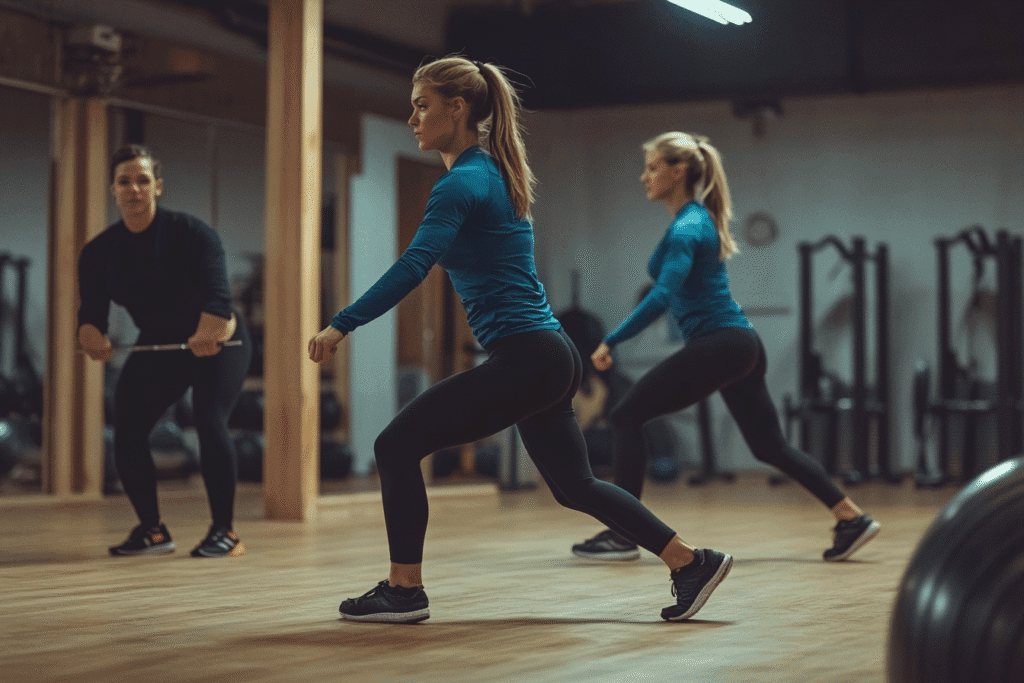
1. Introduction to Nylon Spandex Fabric
Brief Definition and Common Uses in Sportswear
Nylon spandex fabric is a synthetic blend primarily composed of nylon (a durable, lightweight polymer) and spandex (also known as Lycra or elastane, which provides exceptional elasticity). This combination creates a stretchy, form-fitting material that is widely used in activewear, leggings, sports bras, swimwear, and compression garments.
- Nylon contributes to the fabric’s strength, abrasion resistance, and smooth texture.
- Spandex (typically 5–20% of the blend) ensures flexibility, allowing freedom of movement during physical activity.
Due to its moisture-wicking properties and ability to retain shape, nylon spandex is a popular choice for high-performance sportswear, including running, yoga, cycling, and gym wear.
Why Breathability Matters in Athletic Apparel
Breathability refers to a fabric’s ability to allow air circulation and release excess heat and moisture (sweat) from the body. In sportswear, breathability is crucial for:
- Thermoregulation – Preventing overheating during intense workouts.
- Comfort – Reducing sweat buildup, which can cause chafing and discomfort.
- Performance – Keeping athletes dry and cool, improving endurance and focus.
- Hygiene – Minimizing bacterial growth and odor caused by trapped moisture.
If a fabric lacks breathability (e.g., traps heat like pure rubber or thick synthetics), it can lead to excessive sweating, skin irritation, and even heat exhaustion in extreme cases. Therefore, evaluating whether nylon spandex actually allows airflow is crucial for determining its suitability for sportswear.
2. Understanding Breathability in Fabrics
What Makes a Fabric Breathable?
Breathability in fabrics depends on several key factors that influence how well air and moisture pass through the material:
- Fiber Type
- Natural fibers (e.g., cotton, bamboo, merino wool) are inherently breathable due to their porous structure.
- Synthetic fibers (e.g., polyester, nylon, spandex) can be engineered for breathability through moisture-wicking treatments or mesh weaves.
- Fabric Construction
- Knit vs. Woven: Knitted fabrics (like those in activewear) tend to be more breathable due to their looser, stretchable structure.
- Mesh panels & ventilation zones enhance airflow in high-sweat areas (armpits, back).
- Moisture-Wicking Ability
- Breathable fabrics pull sweat away from the skin to the outer layer, where it evaporates.
- Hydrophobic (water-repelling) synthetics like polyester and nylon can still wick moisture but may trap heat if not properly designed.
- Porosity & Air Permeability
- The tightness of the weave/knit affects airflow—looser weaves allow more ventilation.
- Some fabrics use micro-perforations or laser-cut holes (e.g., in running shirts) to improve breathability.
- Weight & Thickness
- Lightweight fabrics (e.g., single-layer nylon spandex) generally breathe better than heavy, dense materials.
How Is Breathability Measured?
Breathability is quantified using standardized tests, including:
- Moisture Vapor Transmission Rate (MVTR)
- Measures how quickly sweat vapor passes through fabric (grams/m²/24 hours).
- Higher MVTR = better breathability (e.g., Gore-Tex: ~15,000 g/m²/24h; standard nylon spandex: ~500–2,000).
- Air Permeability Test (ASTM D737)
- Evaluates how easily air flows through fabric (measured in cm³/cm²/sec).
- Important for fabrics used in high-intensity sports (e.g., cycling jerseys).
- Thermal Resistance (Ret Value)
- Measures heat retention (lower Ret = more breathable).
- Common in sportswear testing (e.g., Ret <6 is ideal for aerobic activity).
- Real-World Wear Trials
- Athlete feedback on heat buildup, sweat evaporation speed, and comfort during exercise.
Key Takeaway:
Breathability isn’t just about “airflow”—it’s a balance of moisture management, fabric structure, and thermal regulation. Nylon spandex can be breathable if designed with these factors in mind, but its performance varies by blend ratio and construction.
3. Nylon Spandex: Composition and Properties
Breakdown of Nylon and Spandex Blend
Nylon spandex fabric is a performance-driven textile that combines two key synthetic fibers:
- Nylon (Polyamide) – Typically makes up 80-95% of the blend.
- Derived from petroleum-based polymers.
- Known for its high strength, abrasion resistance, and smooth texture.
- Naturally water-repellent, but can be treated for moisture-wicking.
- Spandex (Lycra/Elastane) – Usually 5-20% of the blend.
- A synthetic rubber (polyurethane) that provides exceptional elasticity (can stretch 500-600% of its length).
- Adds recovery (returns to original shape after stretching).
- Enhances flexibility and body-hugging fit, crucial for activewear.
Common Blend Ratios in Sportswear:
- 90% Nylon / 10% Spandex – Balanced stretch and durability (common in leggings).
- 85% Nylon / 15% Spandex – Higher elasticity (used in compression wear).
- 80% Nylon / 20% Spandex – Maximum stretch (seen in dancewear or swimsuits).
4. Testing the Breathability of Nylon Spandex
Scientific Studies & Lab Tests on Airflow and Moisture Management
To determine whether nylon spandex is truly breathable for sportswear, researchers conduct controlled tests measuring:
- Moisture Vapor Transmission Rate (MVTR)
- Nylon spandex (standard knit): ~500–2,000 g/m²/24h
*(Lower than polyester’s 1,500–3,500 range, but can improve with moisture-wicking treatments.)* - Gore-Tex (for comparison): ~15,000 g/m²/24h
- Nylon spandex (standard knit): ~500–2,000 g/m²/24h
- Air Permeability (ASTM D737)
- Nylon spandex (tight knit): 5–20 cm³/cm²/sec
*(Less permeable than polyester mesh fabrics, which can exceed 100 cm³/cm²/sec.)* - Open-knit or mesh-paneled nylon spandex improves airflow significantly.
- Nylon spandex (tight knit): 5–20 cm³/cm²/sec
- Thermal Imaging & Heat Retention
- Studies show nylon spandex traps more body heat than moisture-wicking polyester blends.
- Infrared tests reveal higher skin temperature under nylon spandex during high-intensity exercise vs. breathable polyester.
- Sweat Evaporation Rate
- Nylon spandex absorbs less sweat than cotton but dries slower than polyester.
- In humid conditions, sweat lingers on the skin longer, increasing discomfort.
Comparison with Common Sportswear Fabrics
| Fabric | Breathability (MVTR) | Air Permeability | Moisture-Wicking | Heat Retention | Best For |
|---|---|---|---|---|---|
| Nylon Spandex | Moderate (500–2,000) | Low–Moderate (5–20) | Good (if treated) | High (tight knits) | Yoga, light training |
| Polyester | High (1,500–3,500) | High (50–100+) | Excellent | Low (with mesh) | Running, HIIT |
| Cotton | Low (200–500) | Moderate (10–30) | Poor (holds sweat) | Moderate (but gets clammy) | Casual wear |
| Merino Wool | High (1,000–2,500) | Moderate (20–40) | Natural wicking | Low (thermoregulating) | Cold-weather sports |
Key Takeaways:
- Nylon spandex is mid-tier for breathability—better than cotton but often outperformed by advanced polyester blends.
- Stretch vs. Breathability Tradeoff: Higher spandex content (15–20%) reduces airflow but improves flexibility.
- Hybrid designs (e.g., nylon spandex with mesh panels) bridge the gap between stretch and ventilation.
Real-World Performance Feedback
Brands like Lululemon and Under Armour use laser-cut vents and antimicrobial treatments to enhance nylon spandex breathability.
Athlete Surveys:
Positive: Favored for comfort, fit, and durability in low-to-moderate intensity workouts (e.g., pilates, weightlifting).
Negative: Reports of overheating in running/cycling compared to polyester.
Brand Innovations:Brands like Lululemon and Under Armour use laser-cut vents and antimicrobial treatments to enhance nylon spandex breathability.
5. Pros and Cons of Nylon Spandex for Sportswear
Nylon spandex is widely used in activewear, but its performance depends on the type of activity and fabric construction. Below is a detailed breakdown of its advantages and limitations for sportswear.
Advantages of Nylon Spandex
- Superior Flexibility & 4-Way Stretch
- Spandex (even at 5-20% blend) allows full range of motion, making it ideal for:
- Yoga & Pilates (deep stretches)
- High-intensity interval training (HIIT)
- Compression wear (muscle support)
- Recovers shape better than cotton or polyester-spandex blends.
- Spandex (even at 5-20% blend) allows full range of motion, making it ideal for:
- Body-Hugging Fit Without Restriction
- Conforms to the body for a slim, streamlined fit (popular in leggings, sports bras).
- Reduces fabric bunching during movement.
- Lightweight & Smooth Texture
- Feels soft against skin, reducing chafing.
- Thinner than cotton, making it less bulky under layers.
- Durability & Longevity
- Nylon resists pilling, abrasion, and snags better than polyester or cotton.
- Maintains elasticity after repeated washes (if cared for properly).
- Moisture-Wicking (When Treated)
- Sweat evaporates faster than cotton (but slower than polyester).
- Some brands add hydrophilic coatings to improve wicking.
Potential Drawbacks of Nylon Spandex
- Heat Retention in Tight Knits
- Less breathable than polyester or mesh fabrics, leading to:
- Overheating in hot climates
- Discomfort in long-duration cardio (e.g., running, cycling)
- Solution: Look for perforated or open-weave designs.
- Less breathable than polyester or mesh fabrics, leading to:
- Sweat Absorption (Without Wicking Treatments)
- Untreated nylon repels moisture at first, but sweat can pool if not wicked away.
- Compared to polyester, it dries slower, increasing clinginess.
- Odor Retention
- Nylon is more prone to bacterial buildup than antimicrobial fabrics (e.g., merino wool, treated polyester).
- Requires frequent washing with sport-specific detergents.
- Environmental Concerns
- Sheds microplastics when washed (like all synthetics).
- Not biodegradable; recycled nylon (econyl) is a better but pricier alternative.
- UV Degradation
- Prolonged sun exposure weakens nylon fibers, causing fading and reduced elasticity.
When to Choose Nylon Spandex?
✅ Best for:
- Low-to-medium intensity workouts (yoga, weightlifting, barre)
- Form-fitting apparel (leggings, compression shorts)
- Activities where stretch & recovery matter more than extreme breathability
❌ Avoid for:
- Long-distance running in hot weather
- High-sweat activities without moisture-wicking treatments
6. User Experiences and Expert Opinions
Athlete Testimonials & Reviews
Nylon spandex receives mixed feedback depending on the sport and fabric design. Here’s what athletes report:
👍 Positive Feedback:
- Yoga & Pilates Enthusiasts
- *”The 4-way stretch moves with me—no riding up during inversions.”* (Lululemon Align Legging reviews)
- “Smooth fabric prevents mat burns better than polyester.”
- Gym-Goers & Weightlifters
- “Holds its shape through squats and doesn’t bag out like cotton.”
- “Compression feels supportive without restricting blood flow.” (Under Armour HeatGear reviews)
- Dancers & Barre Athletes
- “Stretchy enough for splits but still opaque.”
👎 Negative Feedback:
- Runners & Cyclists
- “Gets too hot on long runs—I switch to polyester mesh in summer.”
- “Traps sweat; feels damp after 5K in humidity.”
- HIIT & CrossFit Athletes
- “Love the fit, but I overheat in full nylon-spandex tops.” (Many opt for side-mesh panels.)
- Hot Climate Workouts
- “Fine for indoor cycling, but I’d never wear it for outdoor tennis in Miami.”
Key Takeaways:
High-intensity/cardio in heat = ⭐⭐ (unless designed for breathability)
Low-sweat, stretch-focused activities = ⭐⭐⭐⭐⭐
Conclusion: Is Nylon Spandex the Right Choice for Sportswear?
Summary of Key Findings on Breathability
- Moderate Breathability – Nylon spandex offers better airflow than cotton but less than polyester or merino wool, especially in tight knits.
- Moisture Management – Wicks sweat when treated, but dries slower than polyester, risking clinginess in high-sweat activities.
- Heat Retention – Can trap body heat in humid or intense conditions, leading to discomfort during long cardio sessions.
- Stretch vs. Ventilation Tradeoff – Higher spandex content (15–20%) improves flexibility but reduces breathability.
Balanced Verdict: Is It Suitable for High-Intensity Workouts?
✅ Yes, if:
- The fabric includes mesh panels, moisture-wicking treatments, or perforations.
- Used for short bursts of activity (e.g., weightlifting, yoga, barre).
- Worn in cooler environments or air-conditioned gyms.
❌ No, if:
- You’re doing long-distance running, cycling, or HIIT in heat.
- You prioritize ultra-lightweight, quick-drying fabrics (opt for polyester or blends).
Alternative Fabrics for Better Performance
If nylon spandex falls short for your needs, consider:
- Polyester-Spandex Blends
- Pros: Superior breathability, faster drying, cheaper.
- Best for: Running, cycling, CrossFit. (Example: Nike Dri-FIT, Adidas Climacool.)
- Merino Wool
- Pros: Naturally temperature-regulating, odor-resistant.
- Best for: Endurance sports, cold-weather training.
- Bamboo Blends
- Pros: Soft, breathable, eco-friendly.
- Best for: Low-impact workouts, sensitive skin.
- Hybrid Nylon-Polyester-Spandex
- Pros: Balances stretch, durability, and airflow.
- Best for: Multi-sport athletes needing versatility.
Final Thoughts: Choosing the Right Sportswear
- For stretch and fit: Nylon spandex is unbeatable (ideal for yoga, Pilates, gym wear).
- For breathability and sweat control: Polyester or merino wool outperform.
- For sustainability: Look for recycled nylon (econyl) or natural fibers.
Pro Tip: Check labels for moisture-wicking certifications (e.g., Oeko-Tex, UV protection) and ventilation features (mesh, laser-cut holes).
Your workout dictates your fabric—choose wisely!
